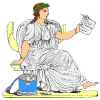Note that four battalions
belonged to a temporary Finnish regiment consisting of contingents from six
provincial Finnish regiments. Because the exact composition of these four
battalions is not known it is difficult to determine what uniforms they
wore. I have however made educated guesses based on which regiments the
battalion commanders belonged to.
Gustaf Adolf Mellin was a recently appointed colonel of Viborg Regiment, Ernst Lode
was lieutenant colonel of Björneborg Regiment
and Patrik Sass was a captain of Savolax Regiment. Which regiment the fourth
battalion commander, major Otto Reinhold Berg, belonged to have I not been
able to determine so I have arbitrarily chosen to represent his battalion
with the uniforms of Nyland Regiment (thus enabling all Finnish colour
combinations to be represented here).

